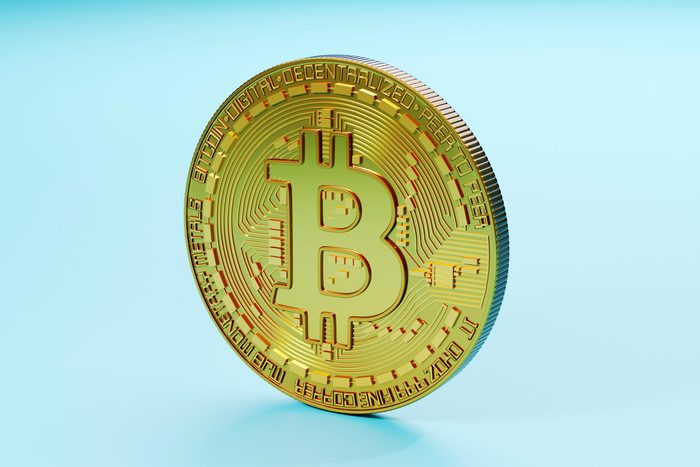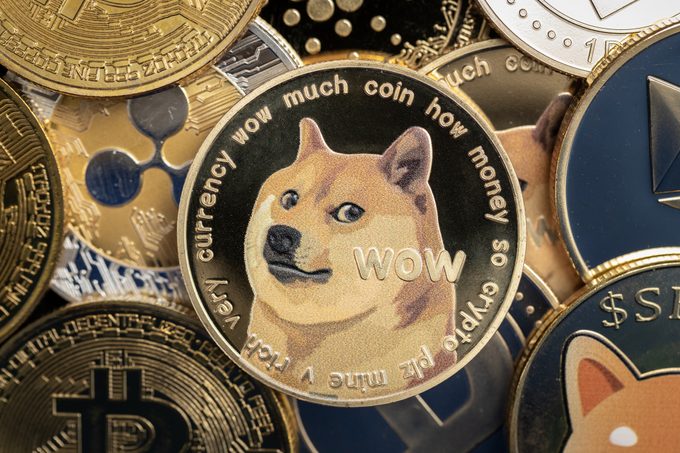What Is Cryptocurrency, and How Does It Work?
Updated: May 01, 2023

In order to get in on crypto investing, you first have to understand how cryptocurrency works
The Reader’s Digest Version:
|
When new technologies (and their seemingly endless terminologies) are introduced, it can be hard to wrap your head around them without googling things like “How does artificial intelligence work?” “What is the metaverse?” and “What is virtual reality?” Looking back, most of the technology we use daily—ATMs, mobile check deposits, digital wallets, Venmo, robot vacuums and Alexa—were abstractions before they became commonplace. Which is why it should come as no surprise that as soon as crypto hit the mainstream, everyone took to the internet to find out the answer to the question of the day: How does cryptocurrency work?
Half of RD.com visitors are familiar with cryptocurrency, but most (95%) have never used it, and 99% have never paid for anything with it. Whether you’re completely clueless about crypto, have a basic understanding or are interested in dipping your toes into digital currency waters, it pays to understand the tech before using it. Keep reading for easy-to-understand answers to questions you’ve probably been wondering since bitcoin entered the scene: How does cryptocurrency work, what can you do with it and what does the future of digital currency hold?
What is crypto?
Cryptocurrency differs from fiat money, which is government-issued legal tender—or paper bills and coins, money the way most people think of it—that isn’t backed by a commodity such as gold or silver. The U.S. dollar, the euro and the yen are all fiat currencies that are governed by a single authority.
Compare that with cryptocurrency, which is digital money—you can’t hold it—and is managed by a decentralized network outside the governance of any country’s economy or government.
“Crypto consists of thousands of digital coins and tokens, minted electronically on a blockchain using cryptography,” says Guy Gotslak, founder and president of Los Angeles–based cryptocurrency exchange My Digital Money. “Cryptography is the science of protecting information by transforming it into a secure format.”
What is blockchain?

Understanding digital currency means going beyond the cryptocurrency definition to learn a new vocabulary. Start with the blockchain, which plays an essential role in cryptocurrency.
“Blockchain is a system in which a record of transactions made in bitcoin or another cryptocurrency is maintained across several computers linked to a peer-to-peer network—a ledger that tracks assets. It’s the backbone of all cryptocurrencies,” explains Neil Bergquist, co-founder and CEO of digital currency exchange Coinme.
The blockchain ledger is duplicated and maintained on numerous computers around the world. Public blockchains are said to be decentralized, which means they’re not controlled by a central authority but, instead, by a network of users.
“A government can’t pass new laws that artificially inflate or deflate its value on the open market,” says Monica Eaton, owner, co-founder and chief operating officer of Chargebacks911, a financial technology cybersecurity company that protects more than 200 million digital purchases every month. “When everything works perfectly, cryptocurrency is secure, confidential and independent of political chicanery.”
What propelled crypto into the mainstream?
Bitcoin put cryptocurrency on the map in 2009 when it was created by Satoshi Nakamoto (a pseudonym for an unknown person or group) and became the first successful decentralized cryptocurrency.
“Nakamoto wrote a nine-page white paper titled ‘Bitcoin: A Peer-to-Peer Electronic Cash System,'” explains Gai Sher, an innovation and tech attorney with extensive experience assisting crypto clients. “The white paper was released 15 days after the Lehman Brothers crash, at a time when confidence and legitimacy in financial institutions diminished dramatically, producing an opportunity for bitcoin to offer a solution.”
“Bitcoin” is a compound of the words “bit” and “coin,” and it’s had a wild ride since Nakamoto created the first 50 bitcoins 13 years ago. “Since then, user adoption and interest in bitcoin has exploded, despite significant market volatility,” Sher says.
The coin has seen extreme swings in price, reaching an all-time high of more than $68,000 in November 2021, only to fall to $18,958 in June 2022. More recently, the price—which, by the time you read this, will no doubt have changed—was $23,422.89 as of Aug. 18, 2022, at 5:03 p.m. ET. You can check current cryptocurrency prices on CoinGecko.
Types of cryptocurrencies
There are more than 20,000 types of cryptocurrency that can be organized by brand (bitcoin, ethereum and tether among them) or by type. Known as the explainer-in-chief of blockchain technology, Omid Malekan is a nine-year veteran of the crypto industry and an adjunct professor at Columbia Business School, where he lectures on blockchain and crypto.
He also spent 3 1/2 years as the in-house crypto expert for Citi Ventures and Citibank, where he worked with executives across the bank and its biggest clients to help them design a strategy on blockchain, crypto, stablecoins, central bank digital currencies and decentralized finance.
If that sounds like a bunch of gobbledygook, don’t worry. Malekan has helped classify and define the various types of cryptocurrency so even newbies can understand the concepts:
Bitcoin
“I am intentionally making bitcoin the solo member of its own category,” Malekan says, “because it has the most recognizable brand name, its total value market cap is the highest, it has the greatest number of unique owners and it’s also the most decentralized.”
Bitcoin is a type of money whose supply is managed by an algorithm and not a government and whose transfers happen on a decentralized network as opposed to a banking system. Anyone can use it to send money to anyone else without permission, like physical cash. While this feature gets a lot of attention in the West for potential criminal use, it also gives hope to people in places where the money is inflationary and the banking system is nonexistent or corrupt.
Smart contract platforms
Like bitcoin, smart contract platforms have decentralized digital currencies that are traded via online exchanges. “But while bitcoin was created as a sort of money with its own payment system, smart contract platforms were invented to be decentralized computing platforms,” Malekan says. “Not only can people use them to send each other coins, but they can program conditions on when and how those payments occur. This feature allows anyone to build an application on top of the blockchain, and many have.”
Decentralized banking and video games are just two examples. “Also unlike bitcoin, these platforms can handle different digital assets [beyond their own native coin], so they can be used to move things like stocks, dollars or digital art,” he says. “Users pay for these services in the platform’s own coin.”
There are dozens of smart contract platforms, but ethereum is by far the most popular and most valuable. It has the highest number of developers building on top of it, the highest number of decentralized applications available on it, the highest number of unique users and the greatest amount of transaction fees paid by users, even more than bitcoin.
The most popular application built atop ethereum is a decentralized exchange called Uniswap, where users trade one digital asset for another. Think of it like the New York Stock Exchange but with users playing the role of brokers and everything getting recorded on the blockchain, not a proprietary database. This exchange has already facilitated more than a trillion dollars worth of trades in the past three years.
Stablecoins
If there’s one thing most people know about crypto, it’s that the market is highly volatile. That makes it difficult to use cryptocurrencies for buying and selling goods.
A stablecoin is an alternative that ties its value to another asset, like the U.S. dollar. They’re frequently backed by reserves of the asset they’re tied to, so a million $1 coins are ideally backed by a million dollars sitting in a bank. Tether is the oldest and largest, but this year, it has been losing ground to USD Coin, another U.S. dollar–pegged cryptocurrency, because there are questions about tether’s operations and how it maintains the cash reserves that back its coins.
Meme coins

This type of crypto is an odd mix of a currency, a community and a sort of joke. The biggest and most recognizable one is dogecoin, which Elon Musk has tweeted about (either genuinely or as a joke) and has said he supports. There is also the shiba inu coin, whose primary appeal may be its low price per coin, which means users can accumulate many units of it.
This category is fluid; there was a time when shiba inu was more valuable than dogecoin. Note that most serious people in the crypto industry do not take these projects seriously, but they have some mass appeal.
Utility tokens
When most people think of cryptocurrency, they think of virtual money. But there’s another element under the crypto umbrella: tokens, which represent noncash assets that can help fund a project and later grant access to its service or facilitate decision-making.
A company creating a crypto platform may issue utility tokens to fund development. Users can later use those tokens to pay for whatever service it offers, such as decentralized cloud storage that’s meant to work like Google Drive or iCloud but without a corporation in charge. Tokens can also be used to vote in governance decisions for decentralized applications. For example, investors who own Uniswap’s UNI token can vote on what new features they’d like the team that created the decentralized exchange to add.
Utility and governance tokens, combined with the programmability of platforms like ethereum, give rise to the relatively new idea of “Web 3.0.” This is a still mostly hypothetical internet where many of the most popular services provided by traditional web companies, such as Facebook, Spotify and StubHub, can eventually be replaced by decentralized alternatives that give users more control and a portion of the profits.
How does cryptocurrency work?
You now know a bit about what crypto is and the types of digital currencies you may encounter. That’s all well and good, you may be thinking, but how does cryptocurrency work, exactly?
Cryptocurrencies are created through the process of mining. “Mining crypto is like mining gold, but instead of digging the ground to find gold, you need to solve cryptographic problems,” Gotslak says. “These cryptographic problems or puzzles were put in place by the creator of the cryptocurrency.”
But it’s not you—the human—who is solving these puzzles and mining cryptocurrency. It’s a computer—or networks of computers.
“There are two methods of mining cryptocurrencies, known as proof of work and proof of stake,” says Nick Ranga, senior cryptocurrency and forex analyst for AskTraders. “The proof-of-work method consists of specialized computers, known as mining rigs, competing to be the first to solve complex mathematical problems, called hashes. The difficulty of the hashes steadily increases over time, which means the computers doing the mining have to become more and more powerful.”
With the proof-of-work method, miners confirm cryptocurrency transactions for inclusion on the blockchain. But it takes a lot of computing power to do this.
Bitcoin uses proof-of-work mining and has been criticized for “the serious environmental ramifications resulting in billions of pounds of carbon dioxide being emitted by miners’ powerful and high-energy-usage computers,” Sher says. (It’s the same reason people say NFTs are bad for the environment.) “Alternative cryptocurrencies have switched or are in the process of switching to alternative validation methods, such as proof of stake.”
This method is a greener alternative to proof-of-work mining. Sher defines it as “a mechanism in which miners use the cryptocurrency they already own to gain access to mining rights equal to the coins they own, which doesn’t require as much energy usage.”
Both methods, however, do more than just confirm cryptocurrency transactions. There is, after all, a reason people want to mine: It offers miners crypto rewards.
How to buy cryptocurrency
“Peer-to-peer crypto sales used to be the primary way crypto was purchased before online exchanges and bitcoin ATMs,” Bergquist says. “Less common now, it is mainly facilitated by decentralized peer-to-peer exchanges that facilitate transactions between users.”
Today, most people investing in cryptocurrency use centralized online exchanges or online brokers. Robinhood and Public.com are great starting points for investors interested in buying and selling stocks, crypto, NFTs and more all on one platform. Sofi is another good option for beginners, and it also offers mortgages, personal loans and student loans.
So, how exactly do you buy digital currency? If you’re new to crypto, you’ll need to purchase using fiat currency like U.S. dollars. If you already have a crypto portfolio, you might trade some of your existing cryptocurrency for another type.
Once you’ve purchased digital currency, you need a place to store it. After all, you can’t shove a handful of bitcoins in your pocket. That’s where digital wallets come in.
Because they cut out the middlemen and don’t store your crypto holdings for you, decentralized exchanges—those peer-to-peer transactions more advanced investors may use—allow people to trade directly from their digital wallets.
“Once you purchase the crypto, you can keep it in a custodial or noncustodial wallet,” Bergquist says. “A custodial wallet is commonly referred to as a ‘hot wallet’ and is centralized and held by an online exchange, so there is no need to remember a private key or secret code. The custodial wallet provider holds this info, so all you need to access crypto funds is to log in to the platform.”
If you use Robinhood, for instance, you’re using a custodial wallet. Considering the ease, why might someone opt to use a different type of wallet? Added protection.
The “cold wallet” is considered the most secure from hackers, though there are risks involved. “A cold wallet is a noncustodial wallet that’s decentralized and only controlled by its user,” Bergquist explains. “It’s essentially a piece of hardware. Some cold wallets resemble USB sticks you connect to a computer through its software. Others represent metal credit cards that have QR codes on them that are managed through a mobile app. The user must remember their private keys and keep them safe with cold wallets. The crypto is lost forever if the private key is forgotten or the cold wallet is thrown away.”
What can cryptocurrency buy?

Cryptocurrency can be used to buy a lot of things these days, with major retailers such as Home Depot, Overstock and Microsoft accepting it for payment. For flights, Expedia and CheapAir.com both accept bitcoin. Camping World, the largest RV dealer in the United States, and Sheets convenience stores accept it too. The list is constantly growing. Starbucks accepts bitcoin through the Bakkt app.
Sotheby’s became the first auction house to accept cryptocurrency last year, and some colleges even accept bitcoin for tuition. AT&T is the first major U.S. mobile company to accept cryptocurrency payments, which it does through BitPay.
“Many merchants are now accepting cryptocurrency as payment,” Bergquist says. “For example, AMC Theaters accept bitcoin, ether, dogecoin and shiba inu as tender. In addition, fashion retailer Gucci recently announced it would accept bitcoin, ethereum and some stablecoins for purchases.”
Want shopping at crypto-accepting retailers to be even easier? Spendabit is a search engine that allows you to search for products and stores that accept bitcoin.
Further in the future, cryptocurrency may be even more commonplace, and people might use digital money to buy everything from dinner to virtual real estate in the metaverse to tickets for the latest space tourism vacation.
But just because you can, doesn’t mean you should. Take the infamous story of the guy who bought two Papa John’s pizzas in 2010 for 10,000 bitcoin. At the time of the purchase, 10,000 bitcoin were worth about $41. If he’d kept those bitcoins—even with bitcoin at a relatively low price today—he’d have $246,320,000 instead of those two pizzas. He clearly should have considered investing in cryptocurrency instead of spending it.
Investing in cryptocurrency
Given the above pizza example, it looks like cryptocurrency can be a good investment. But wherever there is money to be made (and lost), frauds abound.
Crypto is a roughly $2 trillion market, so it’s wise to be aware of potential scams. For instance, on Aug. 1, 2022, the Securities and Exchange Commission charged 11 people in an alleged Ponzi scheme known as Forsage.
In addition to Ponzi schemes, some crypto scams include fake websites that promise huge returns if you keep investing and celebrity endorsements aimed to make you think you can also become a billionaire if you back a specific currency.
“This year, the cryptocurrency industry has been experiencing a bear market and a shakeout in which dozens of companies have gone bankrupt, come under investigation and held mass layoffs,” Gotslak says. “Despite the disappointing crashes for many investors and entrepreneurs, the shakeout is a good thing because it’s separating the businesses that were shady or just in it for a quick buck from those who have long-term staying power in the future of DeFi [decentralized finance]. We’re finding out in real time which coins/tokens have real utility and which were just overhyped trends.”
In an April 2022 speech at the University of Pennsylvania, Securities and Exchange Commission Chair Gary Gensler gave this warning after crypto ads ran during the Super Bowl: “Ads, thus, don’t equal credibility. In crypto, there is lots of innovation but plenty of hype. As in other startup fields, many projects likely could fail. That’s simply part of the entrepreneurial spirit in the U.S.”
Gensler recommends sticking with the bigger names in crypto, as they’re doing the bulk of trading, which is about $100 billion per day. “The crypto market is highly concentrated, with the bulk of trading taking place on only a handful of platforms,” he said. “Among crypto-only exchanges, the top five platforms make up 99% of all trading, and just two platforms make up 80% of trading.”
MaryAlexa Divver, head of product for brokerage and assets at investing platform Public.com, lays it out for people who want to start investing in crypto.
Advantages
- One of the key reasons some investors love crypto is that it removes the need for middlemen or third parties like banks. It enables a direct transfer of funds between two parties. Transfers of funds can also be cheaper, thanks to lower processing fees.
- Cryptocurrency should offer greater ease of payment and reduced volatility as it’s more widely adopted, enabling mobile payments and accessibility to more people.
- Proponents of cryptocurrency say it can eventually eliminate exchange rate risk because all bitcoins will have the same value at the same time, rather than being subject to different rates in different countries.
Disadvantages
- A big thing to watch out for in cryptocurrency is its volatility, as prices have a tendency to surge and drop. For currency, volatility is not a benefit, since the more the price varies, the more reluctant crypto holders will be to use it.
- Some coins are anonymous and/or untraceable, which means they may be used for illegal activity.
“Crypto is a good investment for those who can stomach excessive volatility and risk,” says Cody Garrison, co-founder of Clearblock, a Web3 consulting firm. He offers this common crypto mantra: “Never invest more than you’re willing to lose.”
Is cryptocurrency the future?
Glimpse into the future, and you may see real robots, self-driving cars and 3D printers in every home. There’s a good chance you’ll spot cryptocurrency too.
“Crypto adoption will continue to accelerate, particularly among institutional investors and retail consumers,” Bergquist says. “In addition, people will live multicurrency lives, where they may hold bitcoin, U.S. dollars and other cryptocurrencies as part of a portfolio approach to storing their money.”
He believes digital currencies could revolutionize the way individuals pay one another. “One area that will see continued growth is using cryptocurrencies for global peer-to-peer payments, also known as remittances,” he says. “According to the World Bank, people who send money home through traditional remittance providers pay high fees, ranging from 5% to 9.3% of the transaction amount. Instead, people can send crypto to their friends and family abroad with more funds to support essential needs like food, shelter and clothing. Stablecoins may prove to be the best solution for this use case, as they are tied one-to-one with fiat currency and have less volatility.”
Garrison, too, sees a bright future for crypto. “I absolutely believe cryptocurrency is the future,” he says. “In an ever-globalizing, ever-digitalizing world, it’s the logical next step.”
Sources:
- Guy Gotslak, founder and president of My Digital Money
- Neil Bergquist, co-founder and CEO of Coinme
- Monica Eaton, owner, co-founder and COO of Chargebacks911
- Gai Sher, senior counsel in innovation and technology at Greenspoon Marder
- Omid Malekan, adjunct professor lecturing on blockchain and crypto at Columbia Business School and author of Re-Architecting Trust
- Nick Ranga, senior cryptocurrency and forex analyst for AskTraders
- Bloomberg: “Is Crypto Really Worth $3 Trillion? I Ran the Numbers”
- U.S. Securities and Exchange Commission: “Prepared Remarks of Gary Gensler on Crypto Markets – Penn Law Capital Markets Association Annual Conference”
- MaryAlexa Divver, head of product for brokerage and assets at investing platform Public.com
- Crypto Council for Innovation: “An Analysis of Bitcoin’s Use in Illicit Finance”
- Cody Garrison, co-founder of Clearblock



















